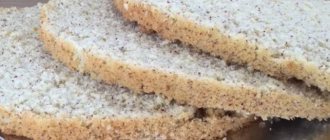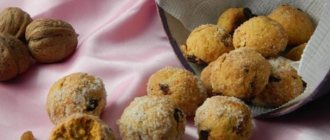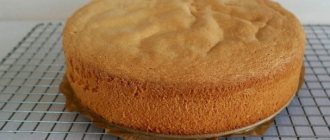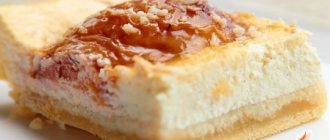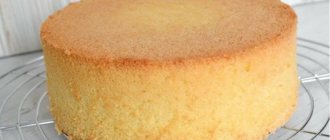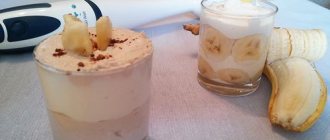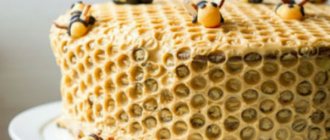In the rich world of confectionery, there are dozens of different biscuits. They are used to make cakes, rolls, pastries and a wide variety of desserts. But for many confectioners, vanilla sponge cake is one of their favorites: light, airy, chiffon-like, almost weightless. Perhaps its main feature is that it is wet, so it does not require additional impregnation. Well, perhaps to give the cakes some special taste. Our article presents a step-by-step recipe with photos of vanilla sponge cake. In practice, several methods of its preparation are used.
Vanilla chiffon sponge cake: ingredients
A moist, heavy, but at the same time unusually fluffy sponge cake is obtained by preparing it according to the following recipe. It is inexpensive, not at all complicated, but surprisingly tasty. The biscuit smells pleasantly of vanilla, and with the help of impregnation it can be given a special taste.
The vanilla chiffon sponge cake recipe (pictured) uses the following ingredients:
- flour – 130 g;
- sugar – 105 g;
- egg – 4 pcs.;
- vanilla sugar – 10 g;
- vegetable oil – 55 g;
- milk – 85 g;
- baking powder - 1.5 tsp;
- salt – 0.25 tsp.
A springform metal mold with a diameter of 18 cm is ideal for cooking.
Is it necessary: why do they add soda to biscuit dough?
Baking soda (sodium bicarbonate, bicarbonate/bicarbonate, NaHCO3) is a chemical compound that helps the cake become fluffy. But for it to start working, it needs to be extinguished.
Photo: depositphotos.com. Author: oxyzay.
It is not necessary to use vinegar, because... all the carbon dioxide that is needed to raise the dough will be gone before mixing. You can extinguish soda with lemon juice or the fermented milk component in the recipe. At the same time, for cakes such as “honey cake” or “Napoleon”, you can add vinegar - it will add additional airiness to the dough.
Preparing biscuit dough
You can prepare a truly delicious sponge cake only if you follow the following recipe exactly step by step:
- For vanilla sponge cake, separate the whites from the yolks. It is important that the dishes are dry and clean, without a drop of water or grease. In total, you will need 4 egg whites and 2 yolks for the biscuit dough.
- In a separate bowl, sift flour, baking powder, salt, vanilla sugar and 80 g of regular sugar. Mix the dry mass with a whisk.
- Pour vegetable oil and warm milk into a bowl with yolks. Mix all ingredients on low speed mixer.
- Gradually add the dry mixture into the egg mixture. Mix with a spatula until a homogeneous consistency is obtained.
- Beat the whites with a mixer until foamy. Add 25 g of sugar and continue to run the mixer at high speed until the protein mass becomes dense and fluffy. As soon as it holds firmly inside the dish, the mixer can be turned off.
- Fold the whipped whites into the main batter in 4 additions. Mix gently with a spatula. The dough should be homogeneous and moderately thick.
A little history
The biscuit has long become a confectionery classic. It is eaten with and without fillings, soaked in rum, cognac and sweet syrups, spread with creams and used as a base for cream cakes. And at birth he was a cracker, even a double cracker.
Literally translated from French, biscuit means twice baked. Five hundred years ago, biscuits were sea biscuits that French sailors took on board on long voyages. The dried cookies contained no oil, kept well and remained tasty. We don’t know who came up with the recipe, but the author’s name could take its rightful place among the great culinary experts - very soon the biscuit was appreciated on land and it settled forever at secular tea parties. In Victorian England, not a single five-o-clock could do without the freshest biscuits coated with cream, and the best pastry chefs were involved in the preparation. Cookies were no longer stored for months; they were served fresh and soft at the tea table.
Improved biscuits returned to France in the 17th century, and from that time their triumphal march around the world began. There is hardly a country in which they do not know how to cook this airy, sweet and satisfying pastry, and in some cuisines biscuits are elevated to the rank of national dishes.
The hallmark of Victorian and modern sponge cake remains fluffiness. The basis of all recipes, without exception, are eggs and sugar beaten to a stable foam and a good oven, as well as accuracy and patience.
Baking a sponge cake
This preparation stage consists of the following mandatory steps:
- Preheat the oven to 160°C. Vanilla sponge cake is baked at low temperature. Then it turns out beautiful and smooth, without cracks or slides in the middle.
- Line the bottom of a metal springform pan with baking paper. It is not recommended to lubricate the sides additionally. This will allow the dough to rise better along the sides of the pan.
- Pour the batter into the prepared pan and smooth it out as much as possible with a spatula.
- Bake the sponge cake for at least 50 minutes. The time it spends in the oven may vary depending on the model of equipment and other characteristics.
- Cook the sponge cake until a dry wooden stick is inserted into the center of the fluffy cake. The splinter should come out dry, without traces of dough.
How to cool a biscuit properly?
To make the cake not only tasty, but also beautiful, it is not enough just to bake a sponge cake. You also need to be able to cool it properly. Experienced confectioners recommend adhering to the following rules:
- Check the readiness of the biscuit with a wooden skewer. If it is dry, remove the pan from the oven and leave it on the counter for a couple of minutes. During this time, the cake will lag behind the walls and will be easier to remove from the mold.
- According to the recipe presented above, the vanilla sponge cake for the cake (pictured) turns out fluffy, tall, slightly convex in the center. But this slide is very easy to get rid of. To do this, turn the sponge cake upside down on a wire rack. Then you need to remove the springform pan and remove the baking parchment.
- After 5 minutes, turn the biscuit over to the other side again. Cool completely.
- Wrap the biscuit in cling film and place it in the refrigerator for at least 2 hours. During this time, the moisture will be evenly distributed inside the cake, and it will become juicier. A sponge cake that has been left in the refrigerator overnight will be much tastier than the one that was immediately used to decorate the cake.
- The sponge cake wrapped in cling film can be frozen. In this form it can be stored in the freezer for up to 1 month.
Answers to key questions
How to replace soda in biscuit dough?
Soda quenched with citric acid is the best option for making a lush cake. If you don’t have it on hand, you can always use vinegar, which is rich in carbon dioxide, or make a cake based on kefir or another fermented milk product. Baking powder is also great.
Baking soda or baking powder: which is better?
Baking soda must be extinguished with citric acid or vinegar. Baking powder already contains soda and acid in order for the reaction to be successful. Both substances do not harm the human body and make the cake fluffy. At the same time, you should not overdo it with soda so that the dough does not become bitter. Whereas an excess of baking powder is not so important. But it is not suitable for recipes in which honey is one of the ingredients.
Should I dissolve soda for biscuits?
Usually baking soda is quenched with lemon juice or table vinegar, but this is not always necessary. For example, if you prepare a cake with kefir or sour milk, you definitely don’t need to extinguish the soda - just add it to the flour. The cake will turn out fluffy anyway, because... kefir itself will cope with the task of extinguishing the soda.
Cooking features and recommendations
Experienced confectioners make any sponge cake perfect. But it is quite possible to bake it at home if you follow the following recommendations during the cooking process:
- When preparing the baking pan, cover the bottom with parchment paper. The walls need not be covered or lubricated with anything, since the fat in this case will prevent the dough from rising. But the sponge cake is not easily removed from every mold. That is why professional confectioners use the “French shirt” method when preparing the mold. The essence of it is to grease the sides from the inside with cold butter, and then sprinkle it with flour on top. Shake off excess. As a result, a thin, barely noticeable layer of flour forms on the walls of the mold, and the finished cake will easily pop out of the mold after baking.
- All products must be weighed or carefully measured. This approach saves a lot of time and effort. If you need to bake several cakes from one portion of dough, then thanks to weighing they will turn out to be the same thickness.
- Never put dough in a cold oven.
- If the sponge cake begins to burn, and a skewer inserted into the center is still wet, you need to cover the cake with foil, the mirror side on top. It will reflect heat, protecting the biscuit from burning.
Mistakes when baking biscuits
The most common mistakes when working with cake dough that affect the final result:
- The dough was not mixed well. The consistency should be homogeneous and without lumps, so it is better to start the timer for 15 minutes and stir the dough for at least this time.
- The temperature was set incorrectly. Biscuits are afraid of the wrong temperature. It often happens that the recipe says one thing, but in reality the specified temperature is not suitable. Much depends on the characteristics of the oven. You may need to bake the crust several times to find the optimal degrees.
- Insufficient cooking time. If you don't finish baking the cake, it will quickly settle.
- Asymmetrical position of the mold inside the oven. Place the crust on the middle shelf.
- Lack of oven seal. Do not open the oven door while the cake is baking.
- Error in proportions and sequence of mixing ingredients. Dry ingredients must first be mixed with flour and only then added to the liquid base.
Is baking soda harmful?
Vanilla sponge cake with starch
The most delicate texture, pleasant taste and divine aroma of vanilla - this is exactly how the dessert will turn out if the cakes for it are prepared according to the following recipe.
It is recommended to prepare vanilla sponge cake in the following order:
- Remove all foods from the refrigerator in advance so that they warm up to room temperature.
- Selected eggs (4 pcs.) of the highest category are divided into whites and yolks.
- Melt butter (30 g) and cool to room temperature.
- Beat the yolks with sugar (55 g) and vanilla (5 g) until the mixture turns white. Add flour (110 g) sifted with corn starch (25 g). Add 45 g of milk and melted butter here.
- Beat the whites first with a pinch of salt and then with sugar (another 55 g).
- Knead the dough with a spatula and transfer it to the mold.
- Bake the biscuit in an oven preheated to 170°C for 40 minutes.
- It is recommended to cool the cake upside down. To do this, you need to turn the form over and place it at a height of 5-10 cm above a horizontal surface, for example, on jars. After 5 minutes, remove the pan and place the biscuit on a wire rack to cool completely. The bottom of the cake should be located at the bottom.
Delicate chiffon sponge cake with squirrels
You can prepare this “air miracle” according to the following recipe:
- Preheat the oven to 160 degrees.
- Sift wheat flour (130 g) with sugar (180 g) and vanillin (3 g).
- Beat the whites of 8 eggs in a mixer at high speed along with citric acid on the tip of a knife and a pinch of salt. When foam appears on the surface of the mass, carefully add powdered sugar (80 g). After 5-7 minutes, the whites will become fluffy, dense, and airy.
- Add the dry mixture into the bowl with the protein mixture. Mix with a hand whisk.
- Place the dough in a baking pan (with a cavity inside). Flatten it with a spoon.
- According to the recipe, the vanilla sponge cake should be baked for 40 minutes. After checking it is ready, turn off the oven and turn the pan over. Leave the biscuit like this for 10 minutes. Then cool it on a wire rack.
Vanilla sponge cake recipe in boiling water
The following sponge cake is ideal for a cake with a lot of berries or fruits. It can be baked in a mold with a diameter of 24 cm. The cake will turn out tall, fluffy and tasty.
The recipe for vanilla sponge cake in boiling water is very simple:
- Beat eggs (4 pcs.) with a mixer until foam forms. Add a package of vanillin and 180 g of sugar. Continue running the mixer for another 5 minutes.
- Sift 170 g of flour and 6 g of baking powder into the egg mixture.
- Pour in 3 tablespoons of boiling water and vegetable oil.
- Using a spatula, knead the dough. Pour it into a mold and place it in an oven preheated to 180°C for 40 minutes.
What is the secret of a fluffy, airy sponge cake?
Photo: depositphotos.com. Author: YanaNavna.
In the case of sponge cake, you should not neglect the advice, since the dough for its preparation is capricious, it is easy to spoil it. To make the cake fluffy and tasty, follow these recommendations:
- Use only fresh eggs, because they are easier to beat into white foam. In this case, they need to be pre-cooled. Beat the yolks and whites separately. It is better to beat the whites until stable peaks form, when the mixture does not flow when turning the bowl over.
- Sift flour into the dough to saturate it with oxygen and make it more fluffy.
- When mixing, follow this sequence: whites into yolks, then flour. Restitch carefully, without sudden movements, so as not to disturb the structure.
- Do not sprinkle the bottom of the cake pan with flour or breadcrumbs. Only butter or baking paper. You can also use a heat-resistant mat or silicone mold.
- Preheat the oven in advance. Once cooked, let the crust sit in the oven for an hour to allow it to settle evenly.
- The baking time for the biscuit can be 10 minutes or one hour. It all depends on the width of the mold and the thickness of the cake.
- To check readiness, just press the surface with your finger: the finished biscuit should spring back.
- Wait until it cools completely and only then remove the biscuit. Otherwise it may break.
Vanilla sponge cake recipe for a slow cooker
According to the following recipe, the sponge cake is tall and porous. It can be served with tea, warm milk or used to make a cake.
A step-by-step recipe for vanilla sponge cake consists of the following steps:
- Beat egg whites (4 pcs.) with a glass of sugar and 20 g of vanilla sugar. When the mass becomes dense, add 4 yolks one at a time, stirring each time with a mixer until smooth.
- Add sifted flour (1 tbsp) into the egg mixture. Mix with a spoon or spatula.
- Grease the multicooker pan with butter. Pour the dough into it.
- Set the cooking mode to “Baking”. In exactly 50 minutes the biscuit will be ready.
Classic recipe with soda
The prepositional cooking method is considered the most common, simple and fast. It’s easy to make any cake, dessert, or even pastry based on it.
The finished dessert can be topped with chocolate glaze, fudge, confiture, or soaked in syrup. It will turn out very tasty and festive.
It can be cut into cubes of the same size to make the legendary cake called "Count's Ruins".
Using your imagination, preparing the classic version will allow you to create a valuable confectionery masterpiece.
Grocery list:
- granulated sugar -1 cup;
- premium flour – 170 grams;
- fresh eggs – 6 pcs.;
- NaHCO3 – 1 teaspoon;
- lemon juice - 1 tbsp. l.;
- powder - for decoration.
Step-by-step preparation of dessert:
- Beat chicken eggs into a bowl and mix thoroughly with sugar using a blender or mixer. The result will be a light and fluffy mass of thick consistency. Beating time is about two minutes.
- Add baking soda and quench with lemon juice, stir thoroughly. Mix flour into eggs.
- Preheat the oven to 180 degrees. Bake for an hour until fully cooked. Remove the cake from the mold and place on a plate.
The classic version of the legendary dessert is ready. You can serve it as an independent treat or prepare a cake by cutting it into several layers and smearing it with cream.
Recommended for you:
How to cook an omelet with baking soda at home
